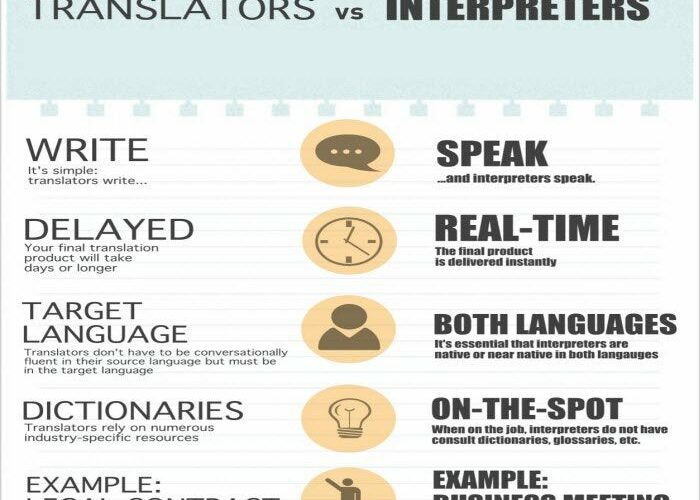Communication is one of the greatest skills you can have in the business world. It becomes even more critical in a face to face meeting where you need to understand and respond in a dynamic setting. There is little room for mistakes. You add in a foreign language and the dynamics become even more complex. In such situations, you might need the services of an interpreter. There are a few misconceptions about the similarities and differences between an interpreter and a translator. Often people ask for a translator when they need an interpreter and vice versa. It is important to understand the difference so you know if you need a translator or an interpreter. Although they are closely related, there are very distinct similarities and differences between the two.
What does a translator do?
A translator converts a written word or audio clip from one language to another. Typically, translators convert the concepts in one language to an equivalent concept in the other language. They need to have a high level of fluency in both languages including speaking, writing, and reading. They also need to have a high level of vocabulary so that they can accurately convert the language. The objective of the translator is to convert the language in a way that it seems as if it were the original. It needs more than just fluency in two languages to become a translator. It requires special training and experience to become a good translator. A translator also needs to be very familiar with cultural references and expressions. In the modern world, some of the translating work is done through a computer whether using emails or video conferencing. Translations can go through a series of revisions before a final version is reached.
What does an interpreter do?
An interpreter converts spoken language or sign language from one language to another. The interpreter listens to the source language and then reproduced the concept into the second language. Some interpreters only go one way, while others might be able to do a two-way interpretation. Typically, interpreters are used in formal settings such as meetings, exhibitions, interviews, or conferences. There are some cases, where the interpreter is required in the courtroom for legal purposes. Interpreting can be done in person, over a phone, or through internet-based technologies. There are different types of interpretation services such as simultaneous interpretation, liaison interpretation, sign-language interpretation, consecutive interpretation.
Similarities between an Interpreter and a translator
Both interpreters and translators work on converting a source language to a target language. They both require the interpreters to have fluency in both source and target language. The level of fluency depends on the expertise level of the professionals. They both need to have a deep understanding of different dialects, common slang phrases, traditions, idioms, cultural nuances, and expressions for both languages. In most cases, both require professional qualifications.
In both cases, a word to word conversion of the source and target language is not good enough. As each language has its own set of grammar and style of sentences, it requires a recreation of the source language to the target language. However, with this recreation, the meaning must not change. The recreation must be able to convey the same tone as the source language.
Differences between an interpreter and a translator
One of the primary differences between the interpreter and translator is that the interpreter has to work around spoken communication or sign language, where a translator mostly works with text or audio clips from websites, newspapers, documents, manuals, medical notes, etc. An interpreter is often required to translate back and forth. For example, an interpreter used for a business meeting would have to listen to one person speak in one language and then immediately translate it into another language for the other person. The interpreter has to keep doing this back and forth.
Another key difference is the interpreter has to translate on the spot, whereas a translator can deliver the translation at a later time. The expectation of an interpreter is different from a translator. For example, interpreters used on news channels for sign language translation, need to go along the flow of the news presenter. A translator has to be more thorough and precise than an interpreter. Depending on the level of interpretation required, the converted material doesn’t have to be as precisely accurate compared to a translation service.
As interpreters work mostly on spoken language, they also need to master voice quality so that their client or audience can clearly understand what they are saying. As the translator doesn’t need to develop this skill.
The training of the interpreter is different from a translator. As the job requirements are different, the interpreter trains on the immediate translation of the source material even if that means some precision is lost whereas translator trains for the thorough conversion of the source language to the other. Translators need to learn different styles of writing required for legal documents, technical papers, medical reports, etc.
The payment mode is also different for an interpreter and a translator. Topically, interpreters are paid on an hourly basis whereas translators are paid based on the project, whether that is per word, per page, or hour. A translator can use reference materials for his job but an interpreter doesn’t have the time to use reference material. A lot of professional translators specialize in one-way translation, typically the target language is their mother tongue or native language.
Key differences summary
- The format is different. Interpreters use speech or sign language, whereas translators mostly use text.
- Interpretation is on the spot where as translation can be done later.
- Accuracy expectation of translators is very high whereas for interpreters it is acceptable to deliver less precise translation.
- Interpreters are typically expected to be equally fluent in both languages whereas translators specialize in one way translation.




